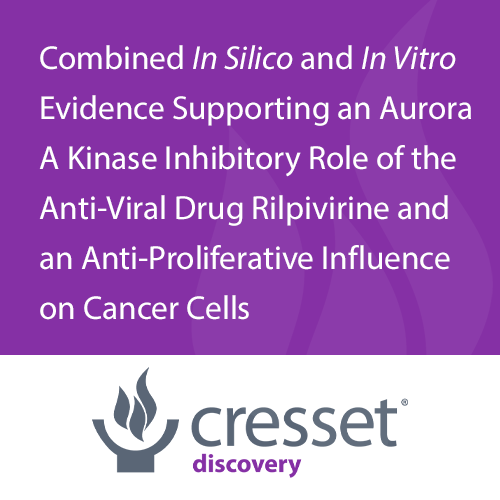Combined In Silico and In Vitro Evidence Supporting an Aurora A Kinase Inhibitory Role of the Anti-Viral Drug Rilpivirine and an Anti-Proliferative Influence on Cancer Cells

Computational chemistry offers a fast and innovative approach to drug discovery and is especially powerful when used in combination with biological testing to provide a complete and reliable picture of a target system. This is perhaps no better illustrated than in Cresset Discovery’s project with University of South Australia, which identified a non-cancer therapeutic as displaying anti-proliferative actions in cancer cell lines and we’re pleased to say that the outcome of this work has recently been published in Pharmaceuticals 1.
Accelerate development timelines with drug repurposing
Despite the advances made in cancer research, the traditional approach to drug development can often be time and resources consuming. To address this, Richard Head’s and Shudong Wang’s team from the Drug Discovery and Development Group, University of South Australia used the concept of drug repurposing – taking existing drugs already clinically approved for their use in other disease areas, to identify those which show anti-cancer activity. One advantage of this approach is that considerable information already exists on a drug’s pharmacology and possible toxicity.
Computational chemistry: A targeted approach to drug repurposing
Drug repurposing has been greatly facilitated by the emergence of in silico screening, which enables high-throughput evaluation of existing compounds. To take a more targeted approach, our team employed Blaze™, Cresset’s advanced ligand-based virtual screening platform to search commercial drug databases using synthetic kinase inhibitor CDKi73 as the template. Cyclin dependent kinases (CDKs) play an important role in cancer biology, as they control the process of cell division – dysregulation of which leads to the aberrant proliferation of cells, the hallmark of cancers. Our Discovery team conducted visual analysis and filtering on the top-ranking 2000 candidates, to exclude any that weren’t at least in the advanced clinical stages of development, as well as any existing kinase inhibitors and evaluation and consideration of any previously reported anticancer activities.
From the resulting shortlist of 73 compounds, the anti-viral drug rilpivirine was selected as a most promising candidate based on the extensive biological testing carried out by University of South Australia. This testing also determined that its key anti-cancer mode of action wasn’t inhibition of CDK9, but instead Aurora A kinase, which has been shown to display abnormal expression in tumor cells 2. Manual docking experiments carried out by our team using Cresset’s comprehensive molecular modeling platform, Flare™, validated rilpivirine’s binding to Aurora A kinase - considering the contextual similarities and differences in inhibition for the two kinase proteins.
The integrated approach shown in this study, illustrates how in silico and in vitro techniques work in synergy to give a complete picture of protein-ligand systems. Virtual screening is a powerful technique that enables research teams to fast track to interesting molecules that can then be progressed for further cellular studies.
Complement your in vitro studies by engaging Cresset Discovery
Cresset Discovery CADD scientists apply their industry knowledge and expertise with sophisticated computational tools to advance your drug discovery performance. If you’d like to find out how we can support you and your team, contact us for a free, confidential discussion.
References
- Islam, S.; Teo, T.; Kumarasiri, M.; Slater, M.; Martin, J. H.; Wang, S. and Head, R. Combined In Silico and In Vitro Evidence Supporting an Aurora A Kinase Inhibitory Role of the Anti-Viral Drug Rilpivirine and an Anti-Proliferative Influence on Cancer Cells. Pharmaceuticals. 2022, 15, 1186.
- Yan, M.; Wang, C.; He, B.; Yang, M.; Tong, M.; Long, Z.; Liu, B.; Peng, F.; Xu, L.; Zhang, Y.; et al. Aurora-a kinase: A potent oncogene and target for cancer therapy. Med. Res. Rev. 2016, 36, 1036–1079.





















